Knowledge and technology drive Valmet roll cover development
Jan 5, 2021
In addition to development in cover materials, modern roll covers may also include sensored intelligence. This is a relatively recent development that began from measurement and control of the CD profiles of parent reels and web tension. Pressure sensing has since spread throughout the paper machine, for example to press rolls, size press rolls, calender rolls and reels. Valmet has extensive experience of all modern materials used for papermaking applications. The solutions we recommend are based on proven technology with three factors in common: economy, reliability and reduced maintenance. Valmet has also been, and will continue to be, active in launching new materials and sensing technology to improve our mill competitiveness.
Covers for challenging process conditions
The papermaking process involves many different applications and related challenges for cover materials. Valmet provides a full range of materials, from ultra-soft rubber and PU all the way to ultra-hard carbides and ceramics. We have developed proprietary cover products and appropriate production methods in all primary material groups for use throughout paper machines, and we work continuously to develop and improve our products.
The major technical parameters to be considered in papermaking applications are moisture level, temperature, mechanical load and the chemical environment. Good solutions for wet conditions may differ markedly from solutions that work best in dry conditions. For example, a wear-resistant release cover for center rolls may not work in dry calendering conditions.The maximum temperature places further limits on the use of various materials, particularly in the drying section. Another basic parameter to consider when comparing different material options is the wet pressing or calendering load together with the frequency of the loading cycle. Finally, exposure to chemicals affects roll covers in several different ways, most commonly erosion, corrosion and diffusion.
Developing advanced solutions
The limitations of available cover materials can be seen in several different problem areas in papermaking. If the main design parameters are chosen appropriately, problems arise slowly – typically over weeks or months. Valmet is always on the lookout for improved solutions to address these problems and extend roll maintenance intervals.
One of the most common slow-scale problems is the wear of cover materials. For certain applications – such as wet pressing, coating, calendering and reeling – the best paper quality or best machine runnability can be obtained with soft roll covers. Sometimes it is even desirable to have the softest cover possible.These covers, though, are prone to wear caused by contact with felts, the paper web and external particles (filler), wrinkles, shear in nip contact, exposure to chemicals and many other causes.
Another common slow-scale roll cover problem is vibration. This applies to soft covers used in a variety of nip contacts where the roll covers need to withstand minor inherent structural vibration for as long as possible without amplifying it further. If the cover develops a vibration pattern that is synchronous with the roll rotation, it's game over and a roll change quickly becomes necessary.
The slow-scale problems with hard coatings typically relate to surface wear or unwanted material accumulating on roll surfaces. This degrades the roll profile, leading to problems in papermaking. One big challenge in cover development is to find wear resistant coatings that do not accumulate dirt under papermaking conditions. Corrosion and loss of coating adhesion on the roll body are also sometimes seen on hard-coated rolls in the longer term.
Wear-resistant rubber covers
Modern rubber covers are based on synthetic rubber compounds. In general, rubber has a high coefficient of heat generation in the loading cycle, which reduces its use in applications where the mechanical load is low or the machine is slow.
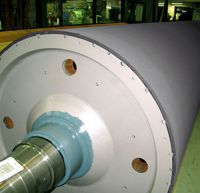
The most typical applications are different guide rolls for fabrics and the paper web, size press rolls, mating rolls of blade coaters and soft reeling cylinders. In some cases rubber covers are also used on primary press rolls, and very occasionally on breaker stack rolls. The typical hardness of rubber covers ranges from 2 to 200 P&J, and the typical thickness from 10 to 50 mm (0.4 to 2.0 in). The cover temperature is ordinarily limited to 90°C (194°F), but some special cases can tolerate temperatures up to 160°C or 170°C (320°F or 338°F).
Minimal heat generation with polyurethane covers
Polyurethane covers have generally been developed for the same applications as rubber covers.The key advantages of polyurethanes are their lower internal heat generation and better wear resistance.These covers need less interior cooling of the rolls, or sometimes none at all, and are also used in some calendering applications.
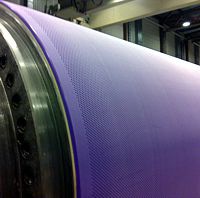
The thermal curing of polyurethanes does not require temperatures as high as the curing of rubber compounds either, which positively affects the economics of production and the types of structures that can be covered. On the other hand, the raw materials for polyurethane covers are more expensive than rubber compounds. Polyurethanes also absorb some water, which must be taken into account in roll maintenance. The typical operating temperature limit is 90°C (194°F) in wet conditions and 110°C to 120°C (230°F to 248°F) in dry conditions.
Composite covers in calendering
Composite covers are harder than rubber or polyurethane covers.Their typical hardness ranges from 85 ShD to 95 ShD and maximum operating temperature limit up to 100°C (212°F).The coefficient of heat generation is usually very low for composites, so internal heat build-up rarely becomes a limiting factor before static strength.
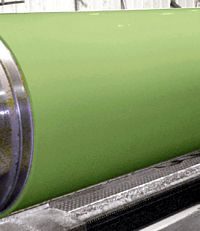
The most obvious use for composite covers is therefore in calendering applications, where pressure levels can reach 100 MPa (14,500 psi). Indeed, online calendering technology was made possible by the development of composite covers. Other applications include different guide rolls, mating rolls, spreader rolls, press rolls and reeling cylinders, where composites provide better wear resistance than softer materials.
Hard coatings for harsh conditions
Hard coatings can be divided into carbide and ceramic coatings. The customary target is to cover a roll with a thin (0.1 - 0.8 mm, .004 - .031 in) and hard protective layer that will improve its wear resistance. These types of applications include center rolls, dryer cylinders, thermo rolls and guide rolls. Carbides and ceramics provide hardness levels above 1,100 HV and therefore give the best wear resistance and are used in the most demanding applications.
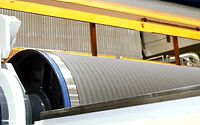
In calendering of glossy paper grades, carbide and ceramic coatings need to be periodically superfinished to keep their surface smooth enough (Ra below 0.2 µm). The typical maintenance interval ranges from six months to two years. In other applications, the targeted roughness is normally around 1 µm, which can be maintained with proper material selection.
Latest technology with sensored rolls
Roll measurements are based on pressure-sensing materials. These are embedded in the roll structure with polymer covers, along with wireless signal transport from the running roll to the external control systems. For most process rolls, knowing the pressure profile is vital to optimizing the papermaking process.
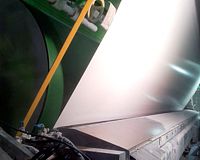
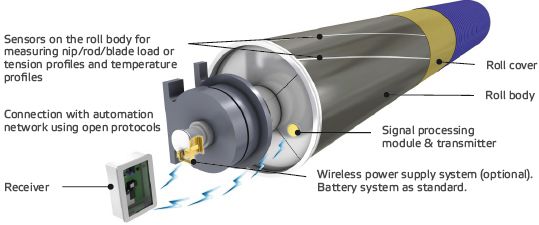
Valmet iRoll systems consist of a high-precision machined roll body with accurate sensors mounted in a helical pattern, roll covers, measurement electronics, interference-free digital radio transmission and a receiver system connected with a user interface.
For example, almost all paper machines have occasional reeling troubles that create a lot of broke and may even result in temporary shutdowns. Measuring reel profiles provides significant advantages in resolving these issues. Another example is the size press, where the quality profile of the paper can be critically affected by the profile of the application rod pressure.
Continuous development through advanced engineering
The variety of different paper machine materials is broad. Valmet can supply dozens of different cover products for specific uses in the papermaking process, all of which are the result of intensive, long-term materials development work. It is just as important to optimize the structural design of covers as the choice of materials. This has been, and will continue to be, a tough but interesting challenge, since the requirements of the papermaking process often exceed the demands of any other industry.
For assistance with your roll cover issues, contact your Valmet representative.